Theories, Concepts, and Frameworks in Education and Training Report
VerifiedAdded on 2023/04/24
|35
|7802
|350
Report
AI Summary
This report delves into various theories, concepts, and frameworks pertinent to education and training. It begins with an introduction to the process of teaching and learning, emphasizing the utilization of diverse techniques, rules, and theories to achieve favorable outcomes. The report then explores systematic and demonstrative learning, highlighting their differences and applications. It further examines Vygotsky's Social Advancement Hypothesis, Gagne's framework, and the scaffolding mastering framework. The report also covers the implementation of these concepts in training, including behaviorism, constructivist theory, and social construction theory. The SMART method is discussed as a tool for goal setting, followed by an analysis of learning preference frameworks such as Honey and Mumford's learning method and Gardner's multiple intelligences. The report concludes with a summary of the key findings and references. Overall, the report provides a comprehensive overview of essential educational theories and frameworks, offering insights into effective teaching and learning practices.
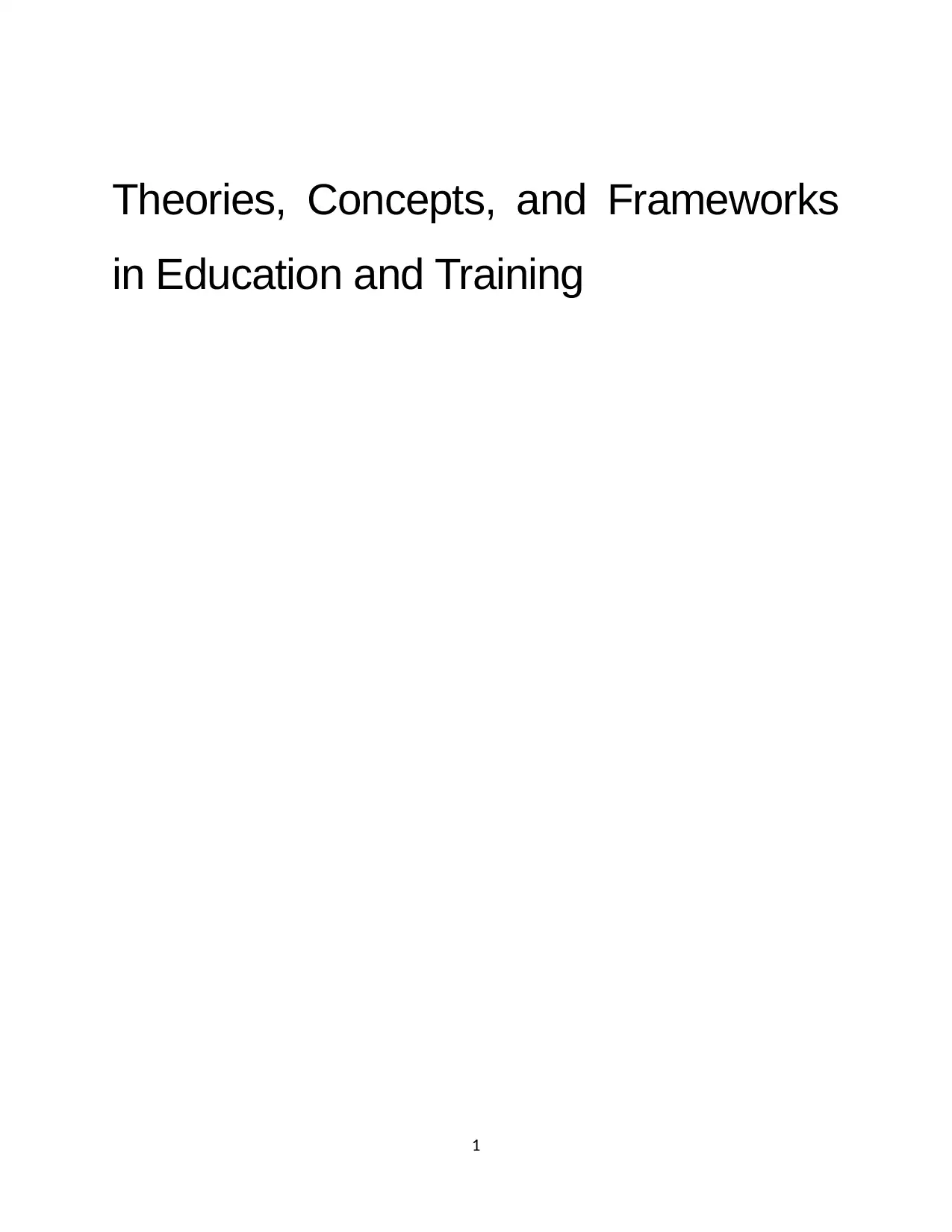
Theories, Concepts, and Frameworks
in Education and Training
1
in Education and Training
1
Paraphrase This Document
Need a fresh take? Get an instant paraphrase of this document with our AI Paraphraser
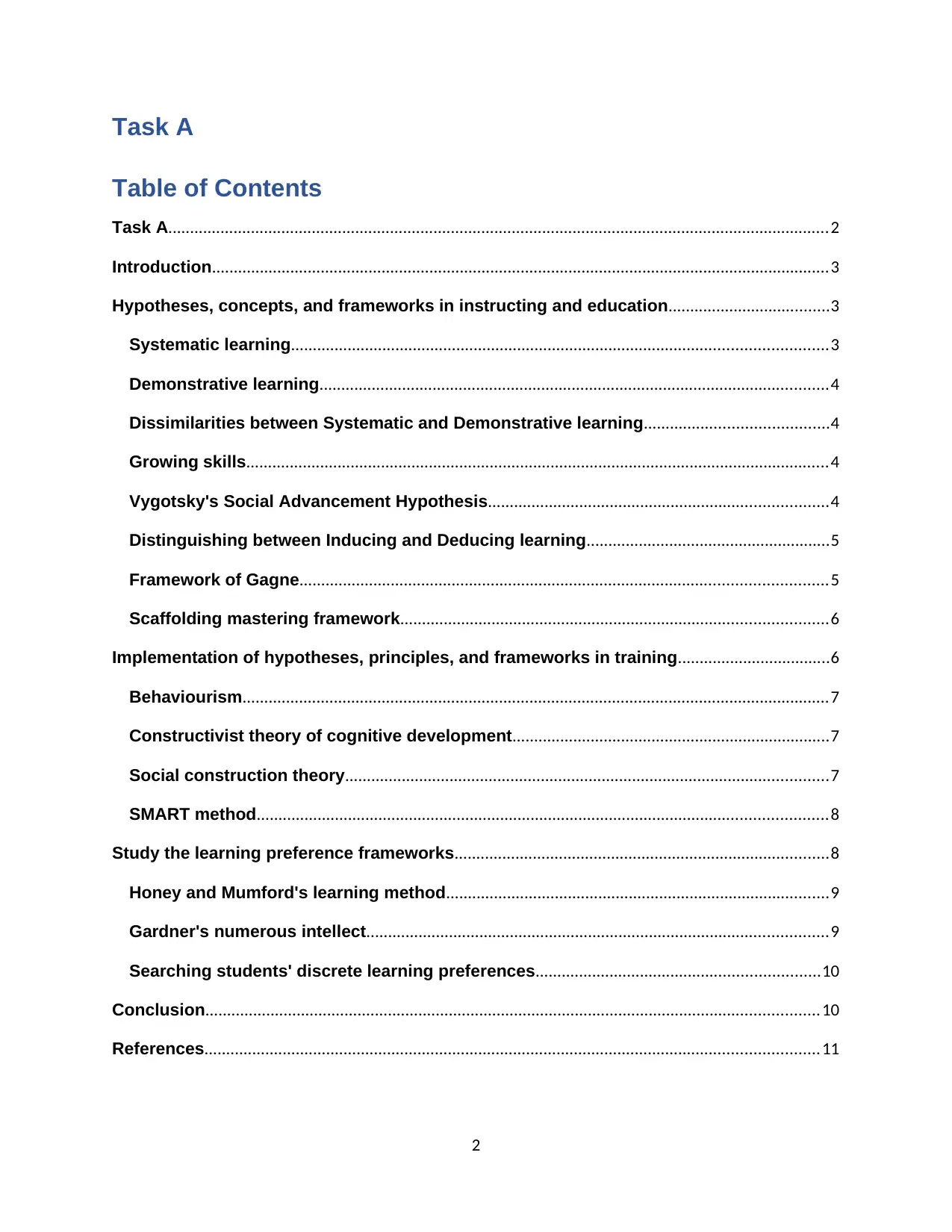
Task A
Table of Contents
Task A........................................................................................................................................................2
Introduction..............................................................................................................................................3
Hypotheses, concepts, and frameworks in instructing and education.....................................3
Systematic learning...........................................................................................................................3
Demonstrative learning.....................................................................................................................4
Dissimilarities between Systematic and Demonstrative learning..........................................4
Growing skills......................................................................................................................................4
Vygotsky's Social Advancement Hypothesis..............................................................................4
Distinguishing between Inducing and Deducing learning........................................................5
Framework of Gagne.........................................................................................................................5
Scaffolding mastering framework..................................................................................................6
Implementation of hypotheses, principles, and frameworks in training...................................6
Behaviourism.......................................................................................................................................7
Constructivist theory of cognitive development.........................................................................7
Social construction theory...............................................................................................................7
SMART method...................................................................................................................................8
Study the learning preference frameworks......................................................................................8
Honey and Mumford's learning method........................................................................................9
Gardner's numerous intellect..........................................................................................................9
Searching students' discrete learning preferences.................................................................10
Conclusion.............................................................................................................................................10
References.............................................................................................................................................11
2
Table of Contents
Task A........................................................................................................................................................2
Introduction..............................................................................................................................................3
Hypotheses, concepts, and frameworks in instructing and education.....................................3
Systematic learning...........................................................................................................................3
Demonstrative learning.....................................................................................................................4
Dissimilarities between Systematic and Demonstrative learning..........................................4
Growing skills......................................................................................................................................4
Vygotsky's Social Advancement Hypothesis..............................................................................4
Distinguishing between Inducing and Deducing learning........................................................5
Framework of Gagne.........................................................................................................................5
Scaffolding mastering framework..................................................................................................6
Implementation of hypotheses, principles, and frameworks in training...................................6
Behaviourism.......................................................................................................................................7
Constructivist theory of cognitive development.........................................................................7
Social construction theory...............................................................................................................7
SMART method...................................................................................................................................8
Study the learning preference frameworks......................................................................................8
Honey and Mumford's learning method........................................................................................9
Gardner's numerous intellect..........................................................................................................9
Searching students' discrete learning preferences.................................................................10
Conclusion.............................................................................................................................................10
References.............................................................................................................................................11
2
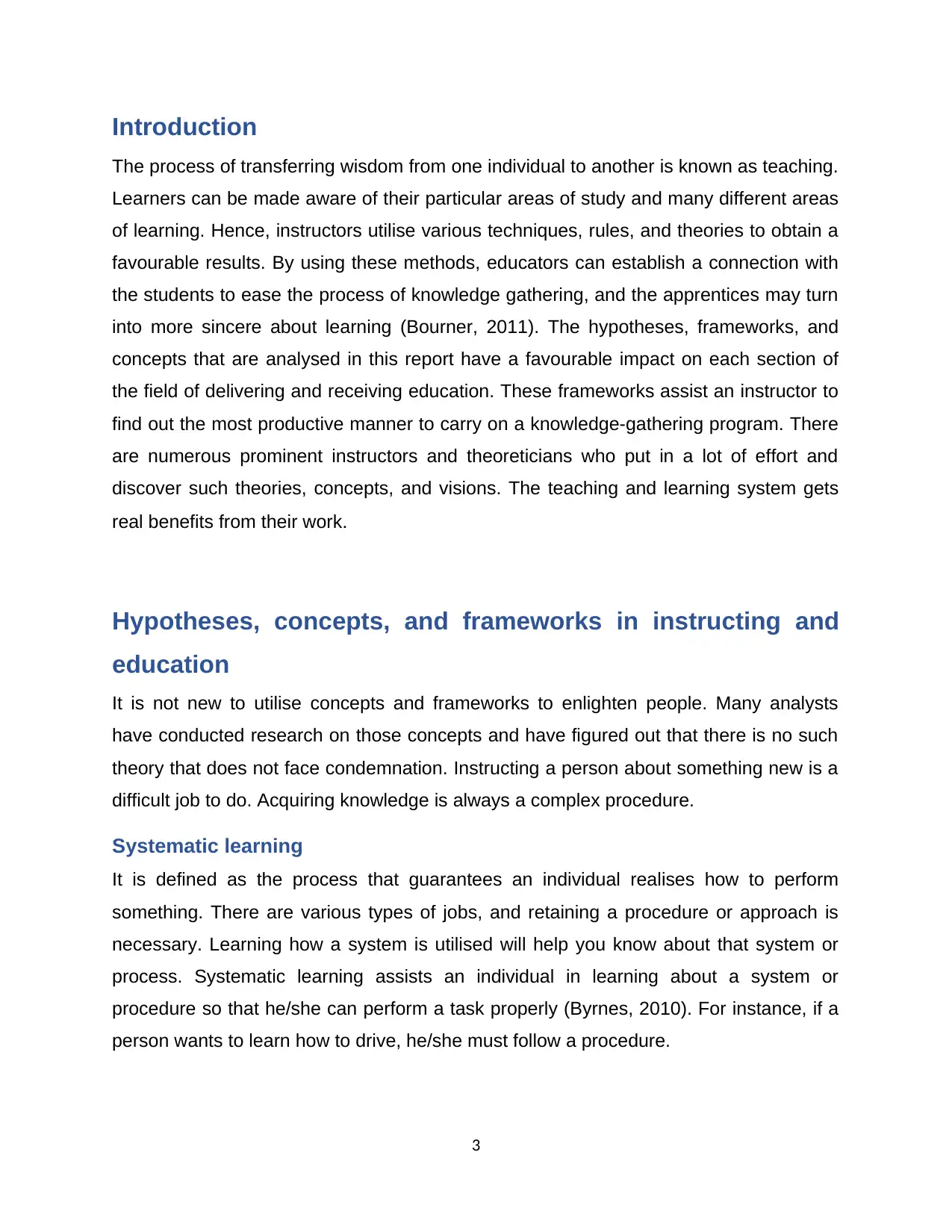
Introduction
The process of transferring wisdom from one individual to another is known as teaching.
Learners can be made aware of their particular areas of study and many different areas
of learning. Hence, instructors utilise various techniques, rules, and theories to obtain a
favourable results. By using these methods, educators can establish a connection with
the students to ease the process of knowledge gathering, and the apprentices may turn
into more sincere about learning (Bourner, 2011). The hypotheses, frameworks, and
concepts that are analysed in this report have a favourable impact on each section of
the field of delivering and receiving education. These frameworks assist an instructor to
find out the most productive manner to carry on a knowledge-gathering program. There
are numerous prominent instructors and theoreticians who put in a lot of effort and
discover such theories, concepts, and visions. The teaching and learning system gets
real benefits from their work.
Hypotheses, concepts, and frameworks in instructing and
education
It is not new to utilise concepts and frameworks to enlighten people. Many analysts
have conducted research on those concepts and have figured out that there is no such
theory that does not face condemnation. Instructing a person about something new is a
difficult job to do. Acquiring knowledge is always a complex procedure.
Systematic learning
It is defined as the process that guarantees an individual realises how to perform
something. There are various types of jobs, and retaining a procedure or approach is
necessary. Learning how a system is utilised will help you know about that system or
process. Systematic learning assists an individual in learning about a system or
procedure so that he/she can perform a task properly (Byrnes, 2010). For instance, if a
person wants to learn how to drive, he/she must follow a procedure.
3
The process of transferring wisdom from one individual to another is known as teaching.
Learners can be made aware of their particular areas of study and many different areas
of learning. Hence, instructors utilise various techniques, rules, and theories to obtain a
favourable results. By using these methods, educators can establish a connection with
the students to ease the process of knowledge gathering, and the apprentices may turn
into more sincere about learning (Bourner, 2011). The hypotheses, frameworks, and
concepts that are analysed in this report have a favourable impact on each section of
the field of delivering and receiving education. These frameworks assist an instructor to
find out the most productive manner to carry on a knowledge-gathering program. There
are numerous prominent instructors and theoreticians who put in a lot of effort and
discover such theories, concepts, and visions. The teaching and learning system gets
real benefits from their work.
Hypotheses, concepts, and frameworks in instructing and
education
It is not new to utilise concepts and frameworks to enlighten people. Many analysts
have conducted research on those concepts and have figured out that there is no such
theory that does not face condemnation. Instructing a person about something new is a
difficult job to do. Acquiring knowledge is always a complex procedure.
Systematic learning
It is defined as the process that guarantees an individual realises how to perform
something. There are various types of jobs, and retaining a procedure or approach is
necessary. Learning how a system is utilised will help you know about that system or
process. Systematic learning assists an individual in learning about a system or
procedure so that he/she can perform a task properly (Byrnes, 2010). For instance, if a
person wants to learn how to drive, he/she must follow a procedure.
3
⊘ This is a preview!⊘
Do you want full access?
Subscribe today to unlock all pages.

Trusted by 1+ million students worldwide
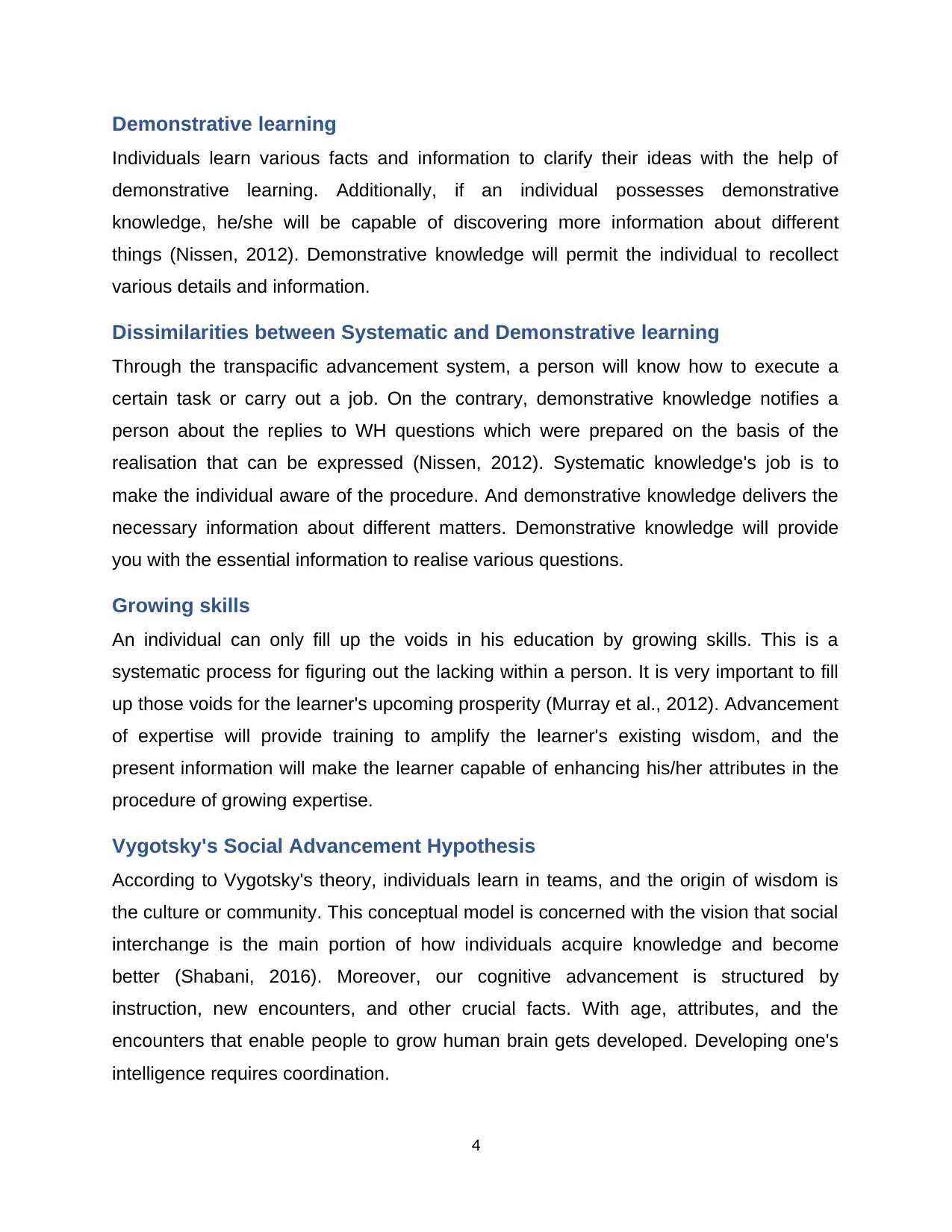
Demonstrative learning
Individuals learn various facts and information to clarify their ideas with the help of
demonstrative learning. Additionally, if an individual possesses demonstrative
knowledge, he/she will be capable of discovering more information about different
things (Nissen, 2012). Demonstrative knowledge will permit the individual to recollect
various details and information.
Dissimilarities between Systematic and Demonstrative learning
Through the transpacific advancement system, a person will know how to execute a
certain task or carry out a job. On the contrary, demonstrative knowledge notifies a
person about the replies to WH questions which were prepared on the basis of the
realisation that can be expressed (Nissen, 2012). Systematic knowledge's job is to
make the individual aware of the procedure. And demonstrative knowledge delivers the
necessary information about different matters. Demonstrative knowledge will provide
you with the essential information to realise various questions.
Growing skills
An individual can only fill up the voids in his education by growing skills. This is a
systematic process for figuring out the lacking within a person. It is very important to fill
up those voids for the learner's upcoming prosperity (Murray et al., 2012). Advancement
of expertise will provide training to amplify the learner's existing wisdom, and the
present information will make the learner capable of enhancing his/her attributes in the
procedure of growing expertise.
Vygotsky's Social Advancement Hypothesis
According to Vygotsky's theory, individuals learn in teams, and the origin of wisdom is
the culture or community. This conceptual model is concerned with the vision that social
interchange is the main portion of how individuals acquire knowledge and become
better (Shabani, 2016). Moreover, our cognitive advancement is structured by
instruction, new encounters, and other crucial facts. With age, attributes, and the
encounters that enable people to grow human brain gets developed. Developing one's
intelligence requires coordination.
4
Individuals learn various facts and information to clarify their ideas with the help of
demonstrative learning. Additionally, if an individual possesses demonstrative
knowledge, he/she will be capable of discovering more information about different
things (Nissen, 2012). Demonstrative knowledge will permit the individual to recollect
various details and information.
Dissimilarities between Systematic and Demonstrative learning
Through the transpacific advancement system, a person will know how to execute a
certain task or carry out a job. On the contrary, demonstrative knowledge notifies a
person about the replies to WH questions which were prepared on the basis of the
realisation that can be expressed (Nissen, 2012). Systematic knowledge's job is to
make the individual aware of the procedure. And demonstrative knowledge delivers the
necessary information about different matters. Demonstrative knowledge will provide
you with the essential information to realise various questions.
Growing skills
An individual can only fill up the voids in his education by growing skills. This is a
systematic process for figuring out the lacking within a person. It is very important to fill
up those voids for the learner's upcoming prosperity (Murray et al., 2012). Advancement
of expertise will provide training to amplify the learner's existing wisdom, and the
present information will make the learner capable of enhancing his/her attributes in the
procedure of growing expertise.
Vygotsky's Social Advancement Hypothesis
According to Vygotsky's theory, individuals learn in teams, and the origin of wisdom is
the culture or community. This conceptual model is concerned with the vision that social
interchange is the main portion of how individuals acquire knowledge and become
better (Shabani, 2016). Moreover, our cognitive advancement is structured by
instruction, new encounters, and other crucial facts. With age, attributes, and the
encounters that enable people to grow human brain gets developed. Developing one's
intelligence requires coordination.
4
Paraphrase This Document
Need a fresh take? Get an instant paraphrase of this document with our AI Paraphraser
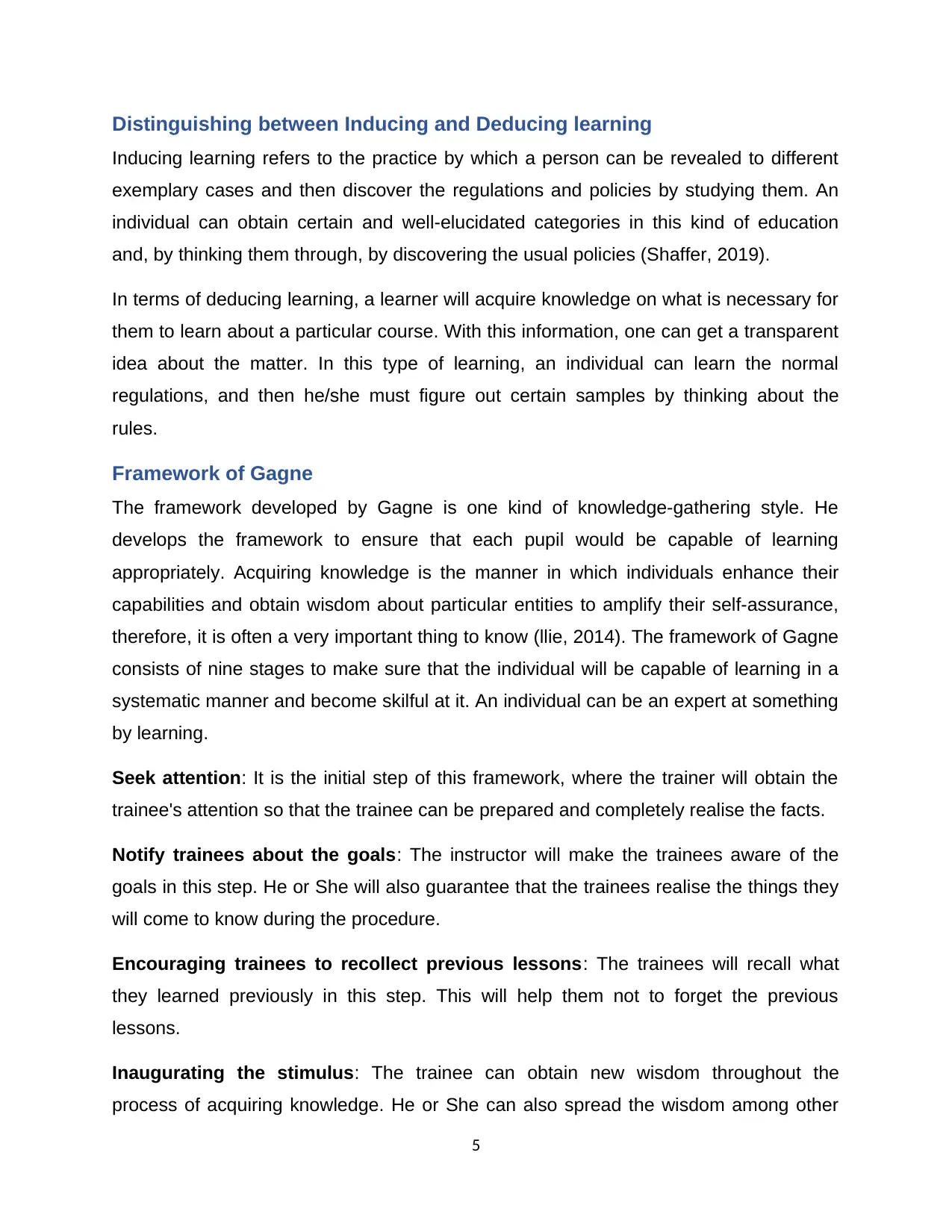
Distinguishing between Inducing and Deducing learning
Inducing learning refers to the practice by which a person can be revealed to different
exemplary cases and then discover the regulations and policies by studying them. An
individual can obtain certain and well-elucidated categories in this kind of education
and, by thinking them through, by discovering the usual policies (Shaffer, 2019).
In terms of deducing learning, a learner will acquire knowledge on what is necessary for
them to learn about a particular course. With this information, one can get a transparent
idea about the matter. In this type of learning, an individual can learn the normal
regulations, and then he/she must figure out certain samples by thinking about the
rules.
Framework of Gagne
The framework developed by Gagne is one kind of knowledge-gathering style. He
develops the framework to ensure that each pupil would be capable of learning
appropriately. Acquiring knowledge is the manner in which individuals enhance their
capabilities and obtain wisdom about particular entities to amplify their self-assurance,
therefore, it is often a very important thing to know (llie, 2014). The framework of Gagne
consists of nine stages to make sure that the individual will be capable of learning in a
systematic manner and become skilful at it. An individual can be an expert at something
by learning.
Seek attention: It is the initial step of this framework, where the trainer will obtain the
trainee's attention so that the trainee can be prepared and completely realise the facts.
Notify trainees about the goals: The instructor will make the trainees aware of the
goals in this step. He or She will also guarantee that the trainees realise the things they
will come to know during the procedure.
Encouraging trainees to recollect previous lessons: The trainees will recall what
they learned previously in this step. This will help them not to forget the previous
lessons.
Inaugurating the stimulus: The trainee can obtain new wisdom throughout the
process of acquiring knowledge. He or She can also spread the wisdom among other
5
Inducing learning refers to the practice by which a person can be revealed to different
exemplary cases and then discover the regulations and policies by studying them. An
individual can obtain certain and well-elucidated categories in this kind of education
and, by thinking them through, by discovering the usual policies (Shaffer, 2019).
In terms of deducing learning, a learner will acquire knowledge on what is necessary for
them to learn about a particular course. With this information, one can get a transparent
idea about the matter. In this type of learning, an individual can learn the normal
regulations, and then he/she must figure out certain samples by thinking about the
rules.
Framework of Gagne
The framework developed by Gagne is one kind of knowledge-gathering style. He
develops the framework to ensure that each pupil would be capable of learning
appropriately. Acquiring knowledge is the manner in which individuals enhance their
capabilities and obtain wisdom about particular entities to amplify their self-assurance,
therefore, it is often a very important thing to know (llie, 2014). The framework of Gagne
consists of nine stages to make sure that the individual will be capable of learning in a
systematic manner and become skilful at it. An individual can be an expert at something
by learning.
Seek attention: It is the initial step of this framework, where the trainer will obtain the
trainee's attention so that the trainee can be prepared and completely realise the facts.
Notify trainees about the goals: The instructor will make the trainees aware of the
goals in this step. He or She will also guarantee that the trainees realise the things they
will come to know during the procedure.
Encouraging trainees to recollect previous lessons: The trainees will recall what
they learned previously in this step. This will help them not to forget the previous
lessons.
Inaugurating the stimulus: The trainee can obtain new wisdom throughout the
process of acquiring knowledge. He or She can also spread the wisdom among other
5
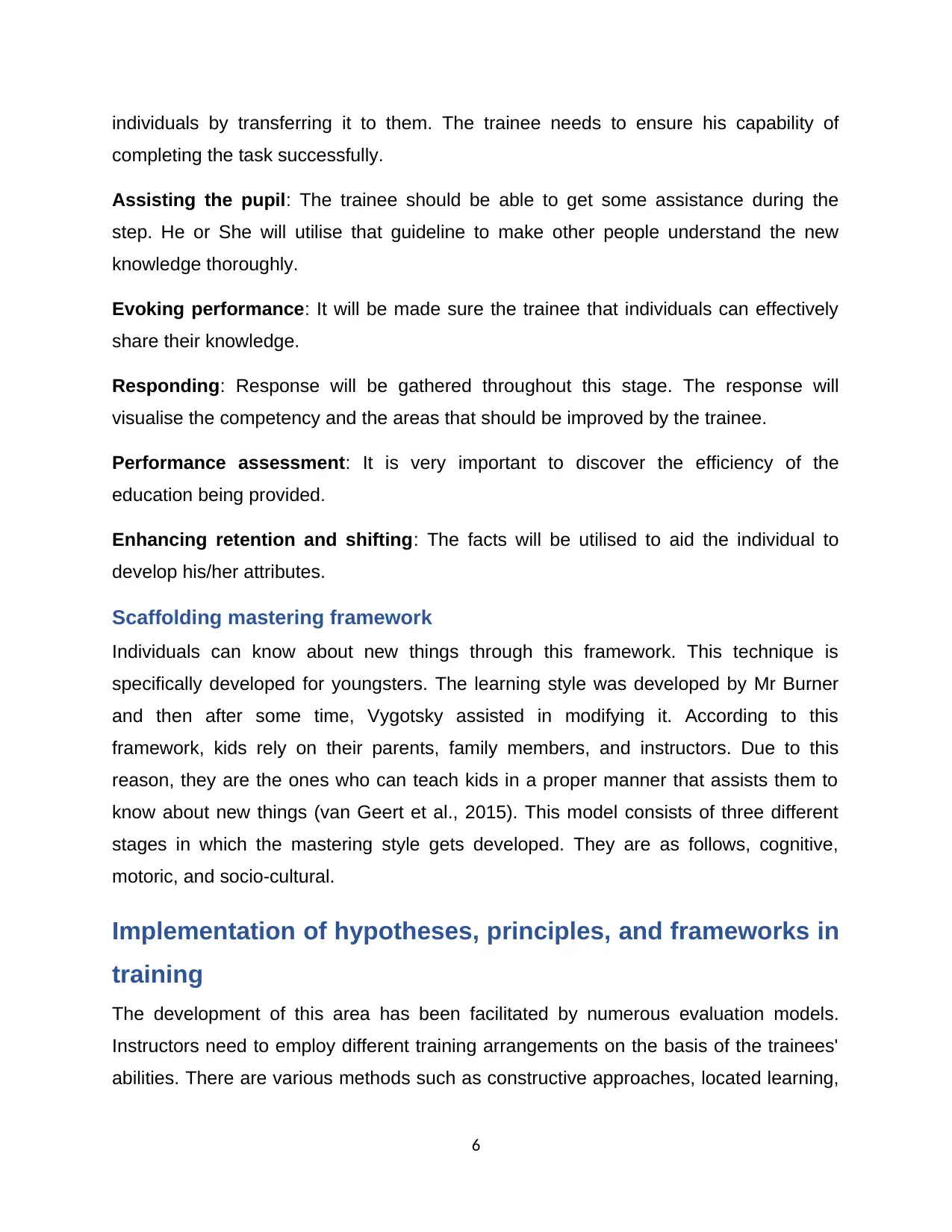
individuals by transferring it to them. The trainee needs to ensure his capability of
completing the task successfully.
Assisting the pupil: The trainee should be able to get some assistance during the
step. He or She will utilise that guideline to make other people understand the new
knowledge thoroughly.
Evoking performance: It will be made sure the trainee that individuals can effectively
share their knowledge.
Responding: Response will be gathered throughout this stage. The response will
visualise the competency and the areas that should be improved by the trainee.
Performance assessment: It is very important to discover the efficiency of the
education being provided.
Enhancing retention and shifting: The facts will be utilised to aid the individual to
develop his/her attributes.
Scaffolding mastering framework
Individuals can know about new things through this framework. This technique is
specifically developed for youngsters. The learning style was developed by Mr Burner
and then after some time, Vygotsky assisted in modifying it. According to this
framework, kids rely on their parents, family members, and instructors. Due to this
reason, they are the ones who can teach kids in a proper manner that assists them to
know about new things (van Geert et al., 2015). This model consists of three different
stages in which the mastering style gets developed. They are as follows, cognitive,
motoric, and socio-cultural.
Implementation of hypotheses, principles, and frameworks in
training
The development of this area has been facilitated by numerous evaluation models.
Instructors need to employ different training arrangements on the basis of the trainees'
abilities. There are various methods such as constructive approaches, located learning,
6
completing the task successfully.
Assisting the pupil: The trainee should be able to get some assistance during the
step. He or She will utilise that guideline to make other people understand the new
knowledge thoroughly.
Evoking performance: It will be made sure the trainee that individuals can effectively
share their knowledge.
Responding: Response will be gathered throughout this stage. The response will
visualise the competency and the areas that should be improved by the trainee.
Performance assessment: It is very important to discover the efficiency of the
education being provided.
Enhancing retention and shifting: The facts will be utilised to aid the individual to
develop his/her attributes.
Scaffolding mastering framework
Individuals can know about new things through this framework. This technique is
specifically developed for youngsters. The learning style was developed by Mr Burner
and then after some time, Vygotsky assisted in modifying it. According to this
framework, kids rely on their parents, family members, and instructors. Due to this
reason, they are the ones who can teach kids in a proper manner that assists them to
know about new things (van Geert et al., 2015). This model consists of three different
stages in which the mastering style gets developed. They are as follows, cognitive,
motoric, and socio-cultural.
Implementation of hypotheses, principles, and frameworks in
training
The development of this area has been facilitated by numerous evaluation models.
Instructors need to employ different training arrangements on the basis of the trainees'
abilities. There are various methods such as constructive approaches, located learning,
6
⊘ This is a preview!⊘
Do you want full access?
Subscribe today to unlock all pages.

Trusted by 1+ million students worldwide
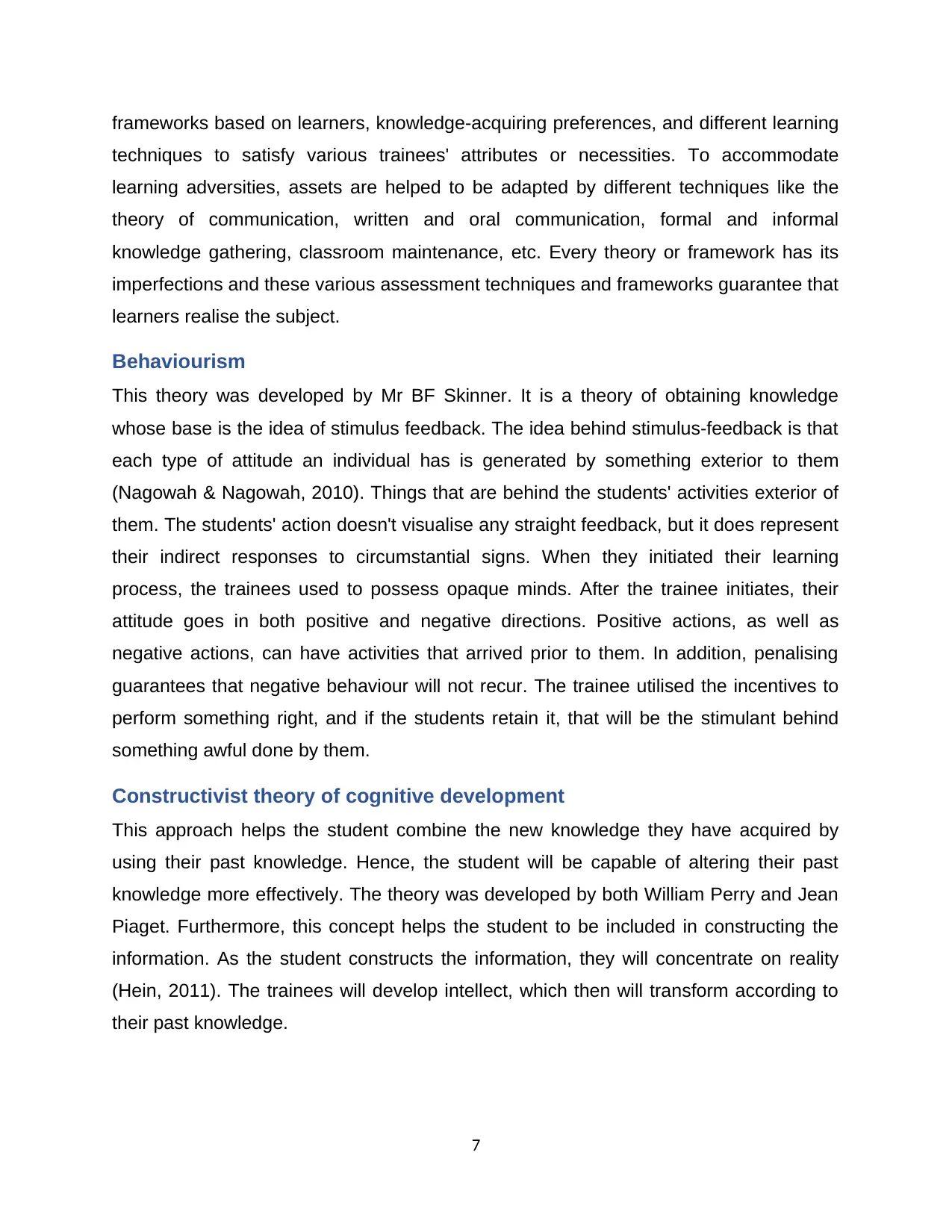
frameworks based on learners, knowledge-acquiring preferences, and different learning
techniques to satisfy various trainees' attributes or necessities. To accommodate
learning adversities, assets are helped to be adapted by different techniques like the
theory of communication, written and oral communication, formal and informal
knowledge gathering, classroom maintenance, etc. Every theory or framework has its
imperfections and these various assessment techniques and frameworks guarantee that
learners realise the subject.
Behaviourism
This theory was developed by Mr BF Skinner. It is a theory of obtaining knowledge
whose base is the idea of stimulus feedback. The idea behind stimulus-feedback is that
each type of attitude an individual has is generated by something exterior to them
(Nagowah & Nagowah, 2010). Things that are behind the students' activities exterior of
them. The students' action doesn't visualise any straight feedback, but it does represent
their indirect responses to circumstantial signs. When they initiated their learning
process, the trainees used to possess opaque minds. After the trainee initiates, their
attitude goes in both positive and negative directions. Positive actions, as well as
negative actions, can have activities that arrived prior to them. In addition, penalising
guarantees that negative behaviour will not recur. The trainee utilised the incentives to
perform something right, and if the students retain it, that will be the stimulant behind
something awful done by them.
Constructivist theory of cognitive development
This approach helps the student combine the new knowledge they have acquired by
using their past knowledge. Hence, the student will be capable of altering their past
knowledge more effectively. The theory was developed by both William Perry and Jean
Piaget. Furthermore, this concept helps the student to be included in constructing the
information. As the student constructs the information, they will concentrate on reality
(Hein, 2011). The trainees will develop intellect, which then will transform according to
their past knowledge.
7
techniques to satisfy various trainees' attributes or necessities. To accommodate
learning adversities, assets are helped to be adapted by different techniques like the
theory of communication, written and oral communication, formal and informal
knowledge gathering, classroom maintenance, etc. Every theory or framework has its
imperfections and these various assessment techniques and frameworks guarantee that
learners realise the subject.
Behaviourism
This theory was developed by Mr BF Skinner. It is a theory of obtaining knowledge
whose base is the idea of stimulus feedback. The idea behind stimulus-feedback is that
each type of attitude an individual has is generated by something exterior to them
(Nagowah & Nagowah, 2010). Things that are behind the students' activities exterior of
them. The students' action doesn't visualise any straight feedback, but it does represent
their indirect responses to circumstantial signs. When they initiated their learning
process, the trainees used to possess opaque minds. After the trainee initiates, their
attitude goes in both positive and negative directions. Positive actions, as well as
negative actions, can have activities that arrived prior to them. In addition, penalising
guarantees that negative behaviour will not recur. The trainee utilised the incentives to
perform something right, and if the students retain it, that will be the stimulant behind
something awful done by them.
Constructivist theory of cognitive development
This approach helps the student combine the new knowledge they have acquired by
using their past knowledge. Hence, the student will be capable of altering their past
knowledge more effectively. The theory was developed by both William Perry and Jean
Piaget. Furthermore, this concept helps the student to be included in constructing the
information. As the student constructs the information, they will concentrate on reality
(Hein, 2011). The trainees will develop intellect, which then will transform according to
their past knowledge.
7
Paraphrase This Document
Need a fresh take? Get an instant paraphrase of this document with our AI Paraphraser
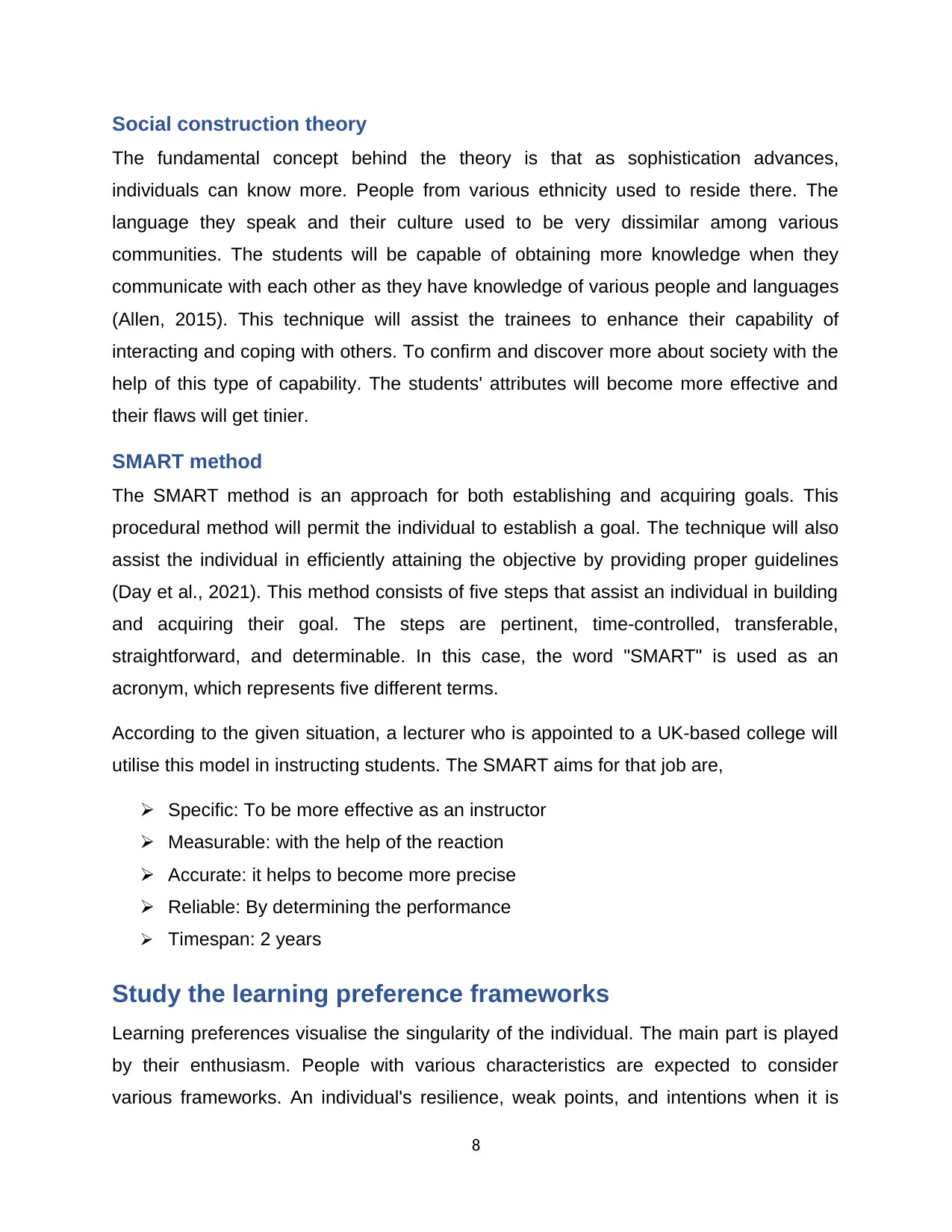
Social construction theory
The fundamental concept behind the theory is that as sophistication advances,
individuals can know more. People from various ethnicity used to reside there. The
language they speak and their culture used to be very dissimilar among various
communities. The students will be capable of obtaining more knowledge when they
communicate with each other as they have knowledge of various people and languages
(Allen, 2015). This technique will assist the trainees to enhance their capability of
interacting and coping with others. To confirm and discover more about society with the
help of this type of capability. The students' attributes will become more effective and
their flaws will get tinier.
SMART method
The SMART method is an approach for both establishing and acquiring goals. This
procedural method will permit the individual to establish a goal. The technique will also
assist the individual in efficiently attaining the objective by providing proper guidelines
(Day et al., 2021). This method consists of five steps that assist an individual in building
and acquiring their goal. The steps are pertinent, time-controlled, transferable,
straightforward, and determinable. In this case, the word "SMART" is used as an
acronym, which represents five different terms.
According to the given situation, a lecturer who is appointed to a UK-based college will
utilise this model in instructing students. The SMART aims for that job are,
Specific: To be more effective as an instructor
Measurable: with the help of the reaction
Accurate: it helps to become more precise
Reliable: By determining the performance
Timespan: 2 years
Study the learning preference frameworks
Learning preferences visualise the singularity of the individual. The main part is played
by their enthusiasm. People with various characteristics are expected to consider
various frameworks. An individual's resilience, weak points, and intentions when it is
8
The fundamental concept behind the theory is that as sophistication advances,
individuals can know more. People from various ethnicity used to reside there. The
language they speak and their culture used to be very dissimilar among various
communities. The students will be capable of obtaining more knowledge when they
communicate with each other as they have knowledge of various people and languages
(Allen, 2015). This technique will assist the trainees to enhance their capability of
interacting and coping with others. To confirm and discover more about society with the
help of this type of capability. The students' attributes will become more effective and
their flaws will get tinier.
SMART method
The SMART method is an approach for both establishing and acquiring goals. This
procedural method will permit the individual to establish a goal. The technique will also
assist the individual in efficiently attaining the objective by providing proper guidelines
(Day et al., 2021). This method consists of five steps that assist an individual in building
and acquiring their goal. The steps are pertinent, time-controlled, transferable,
straightforward, and determinable. In this case, the word "SMART" is used as an
acronym, which represents five different terms.
According to the given situation, a lecturer who is appointed to a UK-based college will
utilise this model in instructing students. The SMART aims for that job are,
Specific: To be more effective as an instructor
Measurable: with the help of the reaction
Accurate: it helps to become more precise
Reliable: By determining the performance
Timespan: 2 years
Study the learning preference frameworks
Learning preferences visualise the singularity of the individual. The main part is played
by their enthusiasm. People with various characteristics are expected to consider
various frameworks. An individual's resilience, weak points, and intentions when it is
8
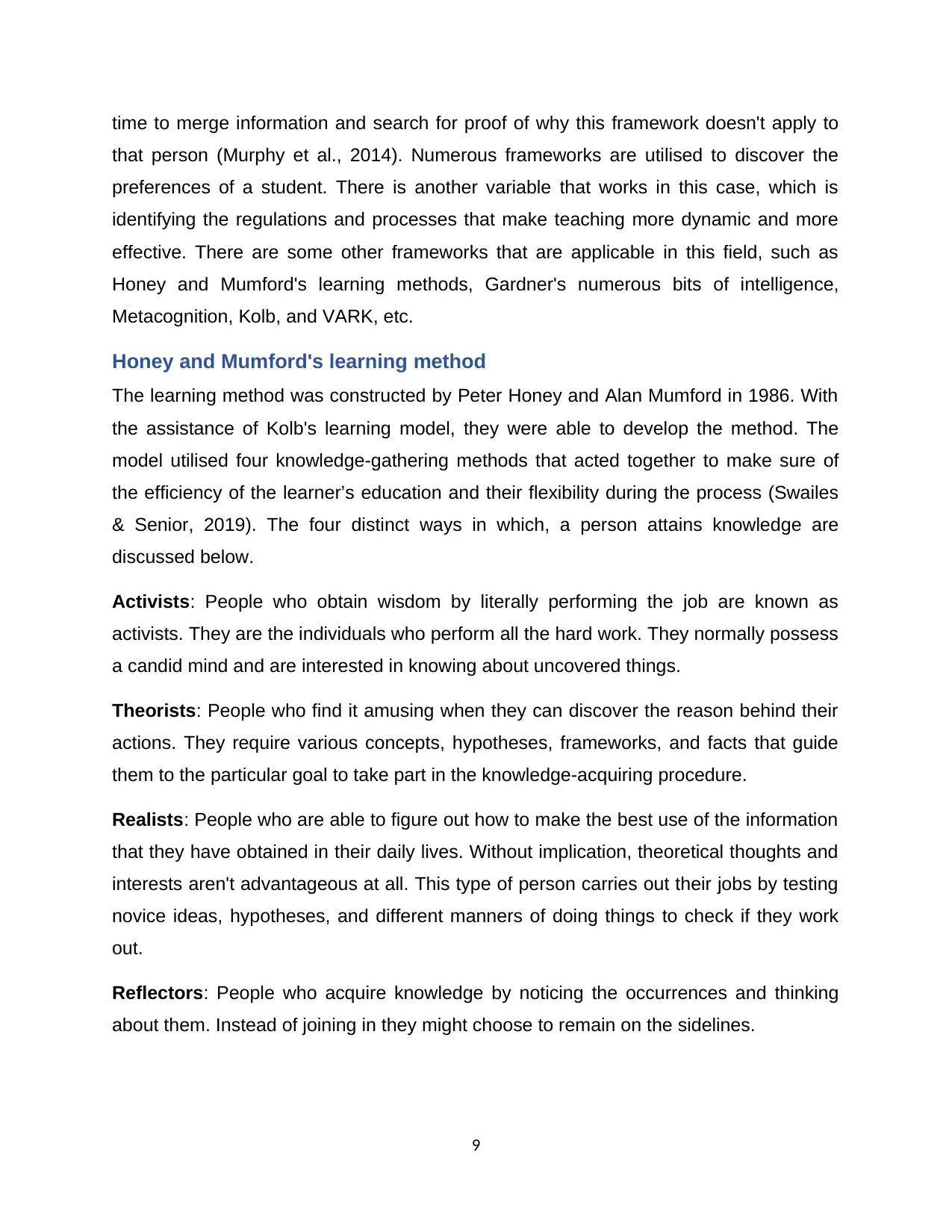
time to merge information and search for proof of why this framework doesn't apply to
that person (Murphy et al., 2014). Numerous frameworks are utilised to discover the
preferences of a student. There is another variable that works in this case, which is
identifying the regulations and processes that make teaching more dynamic and more
effective. There are some other frameworks that are applicable in this field, such as
Honey and Mumford's learning methods, Gardner's numerous bits of intelligence,
Metacognition, Kolb, and VARK, etc.
Honey and Mumford's learning method
The learning method was constructed by Peter Honey and Alan Mumford in 1986. With
the assistance of Kolb's learning model, they were able to develop the method. The
model utilised four knowledge-gathering methods that acted together to make sure of
the efficiency of the learner’s education and their flexibility during the process (Swailes
& Senior, 2019). The four distinct ways in which, a person attains knowledge are
discussed below.
Activists: People who obtain wisdom by literally performing the job are known as
activists. They are the individuals who perform all the hard work. They normally possess
a candid mind and are interested in knowing about uncovered things.
Theorists: People who find it amusing when they can discover the reason behind their
actions. They require various concepts, hypotheses, frameworks, and facts that guide
them to the particular goal to take part in the knowledge-acquiring procedure.
Realists: People who are able to figure out how to make the best use of the information
that they have obtained in their daily lives. Without implication, theoretical thoughts and
interests aren't advantageous at all. This type of person carries out their jobs by testing
novice ideas, hypotheses, and different manners of doing things to check if they work
out.
Reflectors: People who acquire knowledge by noticing the occurrences and thinking
about them. Instead of joining in they might choose to remain on the sidelines.
9
that person (Murphy et al., 2014). Numerous frameworks are utilised to discover the
preferences of a student. There is another variable that works in this case, which is
identifying the regulations and processes that make teaching more dynamic and more
effective. There are some other frameworks that are applicable in this field, such as
Honey and Mumford's learning methods, Gardner's numerous bits of intelligence,
Metacognition, Kolb, and VARK, etc.
Honey and Mumford's learning method
The learning method was constructed by Peter Honey and Alan Mumford in 1986. With
the assistance of Kolb's learning model, they were able to develop the method. The
model utilised four knowledge-gathering methods that acted together to make sure of
the efficiency of the learner’s education and their flexibility during the process (Swailes
& Senior, 2019). The four distinct ways in which, a person attains knowledge are
discussed below.
Activists: People who obtain wisdom by literally performing the job are known as
activists. They are the individuals who perform all the hard work. They normally possess
a candid mind and are interested in knowing about uncovered things.
Theorists: People who find it amusing when they can discover the reason behind their
actions. They require various concepts, hypotheses, frameworks, and facts that guide
them to the particular goal to take part in the knowledge-acquiring procedure.
Realists: People who are able to figure out how to make the best use of the information
that they have obtained in their daily lives. Without implication, theoretical thoughts and
interests aren't advantageous at all. This type of person carries out their jobs by testing
novice ideas, hypotheses, and different manners of doing things to check if they work
out.
Reflectors: People who acquire knowledge by noticing the occurrences and thinking
about them. Instead of joining in they might choose to remain on the sidelines.
9
⊘ This is a preview!⊘
Do you want full access?
Subscribe today to unlock all pages.

Trusted by 1+ million students worldwide
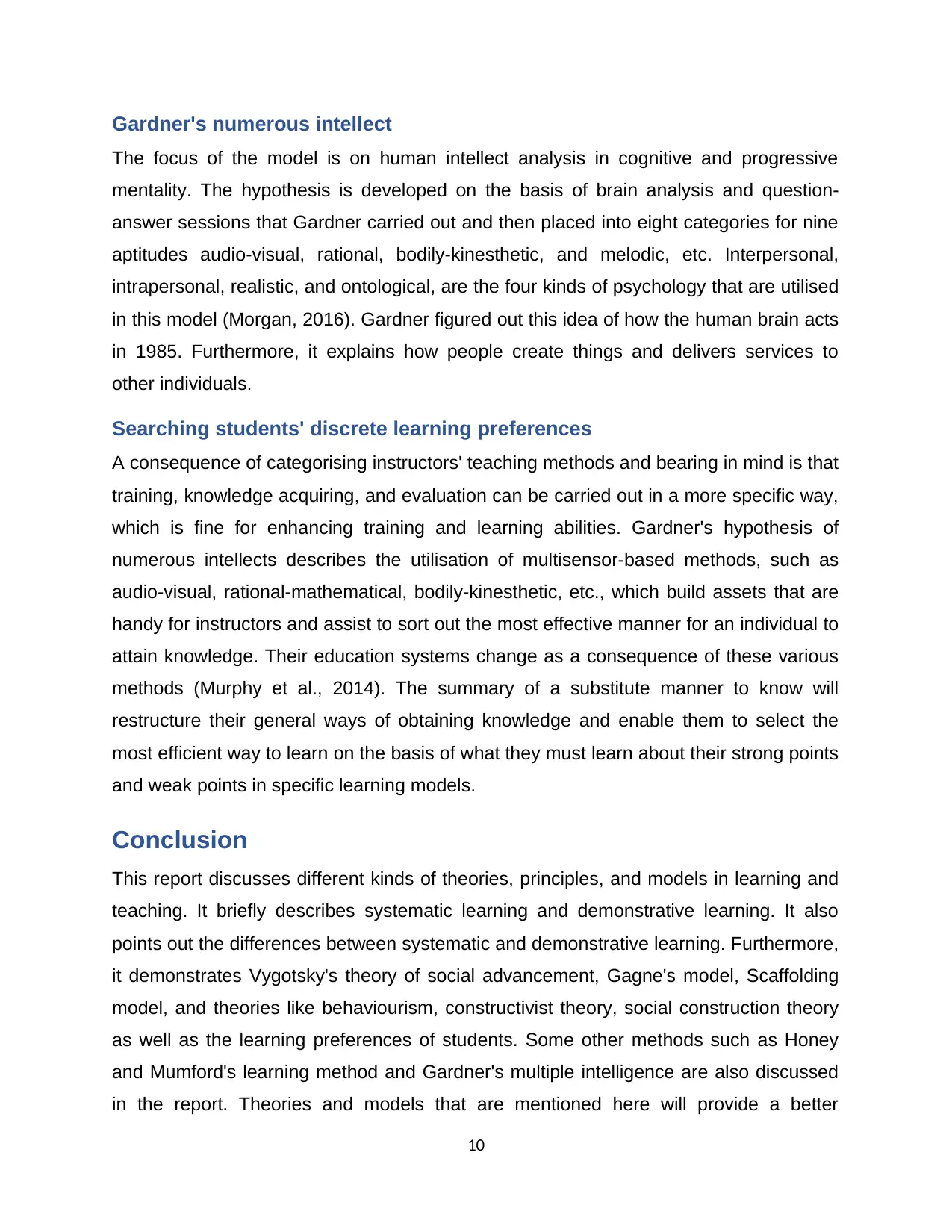
Gardner's numerous intellect
The focus of the model is on human intellect analysis in cognitive and progressive
mentality. The hypothesis is developed on the basis of brain analysis and question-
answer sessions that Gardner carried out and then placed into eight categories for nine
aptitudes audio-visual, rational, bodily-kinesthetic, and melodic, etc. Interpersonal,
intrapersonal, realistic, and ontological, are the four kinds of psychology that are utilised
in this model (Morgan, 2016). Gardner figured out this idea of how the human brain acts
in 1985. Furthermore, it explains how people create things and delivers services to
other individuals.
Searching students' discrete learning preferences
A consequence of categorising instructors' teaching methods and bearing in mind is that
training, knowledge acquiring, and evaluation can be carried out in a more specific way,
which is fine for enhancing training and learning abilities. Gardner's hypothesis of
numerous intellects describes the utilisation of multisensor-based methods, such as
audio-visual, rational-mathematical, bodily-kinesthetic, etc., which build assets that are
handy for instructors and assist to sort out the most effective manner for an individual to
attain knowledge. Their education systems change as a consequence of these various
methods (Murphy et al., 2014). The summary of a substitute manner to know will
restructure their general ways of obtaining knowledge and enable them to select the
most efficient way to learn on the basis of what they must learn about their strong points
and weak points in specific learning models.
Conclusion
This report discusses different kinds of theories, principles, and models in learning and
teaching. It briefly describes systematic learning and demonstrative learning. It also
points out the differences between systematic and demonstrative learning. Furthermore,
it demonstrates Vygotsky's theory of social advancement, Gagne's model, Scaffolding
model, and theories like behaviourism, constructivist theory, social construction theory
as well as the learning preferences of students. Some other methods such as Honey
and Mumford's learning method and Gardner's multiple intelligence are also discussed
in the report. Theories and models that are mentioned here will provide a better
10
The focus of the model is on human intellect analysis in cognitive and progressive
mentality. The hypothesis is developed on the basis of brain analysis and question-
answer sessions that Gardner carried out and then placed into eight categories for nine
aptitudes audio-visual, rational, bodily-kinesthetic, and melodic, etc. Interpersonal,
intrapersonal, realistic, and ontological, are the four kinds of psychology that are utilised
in this model (Morgan, 2016). Gardner figured out this idea of how the human brain acts
in 1985. Furthermore, it explains how people create things and delivers services to
other individuals.
Searching students' discrete learning preferences
A consequence of categorising instructors' teaching methods and bearing in mind is that
training, knowledge acquiring, and evaluation can be carried out in a more specific way,
which is fine for enhancing training and learning abilities. Gardner's hypothesis of
numerous intellects describes the utilisation of multisensor-based methods, such as
audio-visual, rational-mathematical, bodily-kinesthetic, etc., which build assets that are
handy for instructors and assist to sort out the most effective manner for an individual to
attain knowledge. Their education systems change as a consequence of these various
methods (Murphy et al., 2014). The summary of a substitute manner to know will
restructure their general ways of obtaining knowledge and enable them to select the
most efficient way to learn on the basis of what they must learn about their strong points
and weak points in specific learning models.
Conclusion
This report discusses different kinds of theories, principles, and models in learning and
teaching. It briefly describes systematic learning and demonstrative learning. It also
points out the differences between systematic and demonstrative learning. Furthermore,
it demonstrates Vygotsky's theory of social advancement, Gagne's model, Scaffolding
model, and theories like behaviourism, constructivist theory, social construction theory
as well as the learning preferences of students. Some other methods such as Honey
and Mumford's learning method and Gardner's multiple intelligence are also discussed
in the report. Theories and models that are mentioned here will provide a better
10
Paraphrase This Document
Need a fresh take? Get an instant paraphrase of this document with our AI Paraphraser
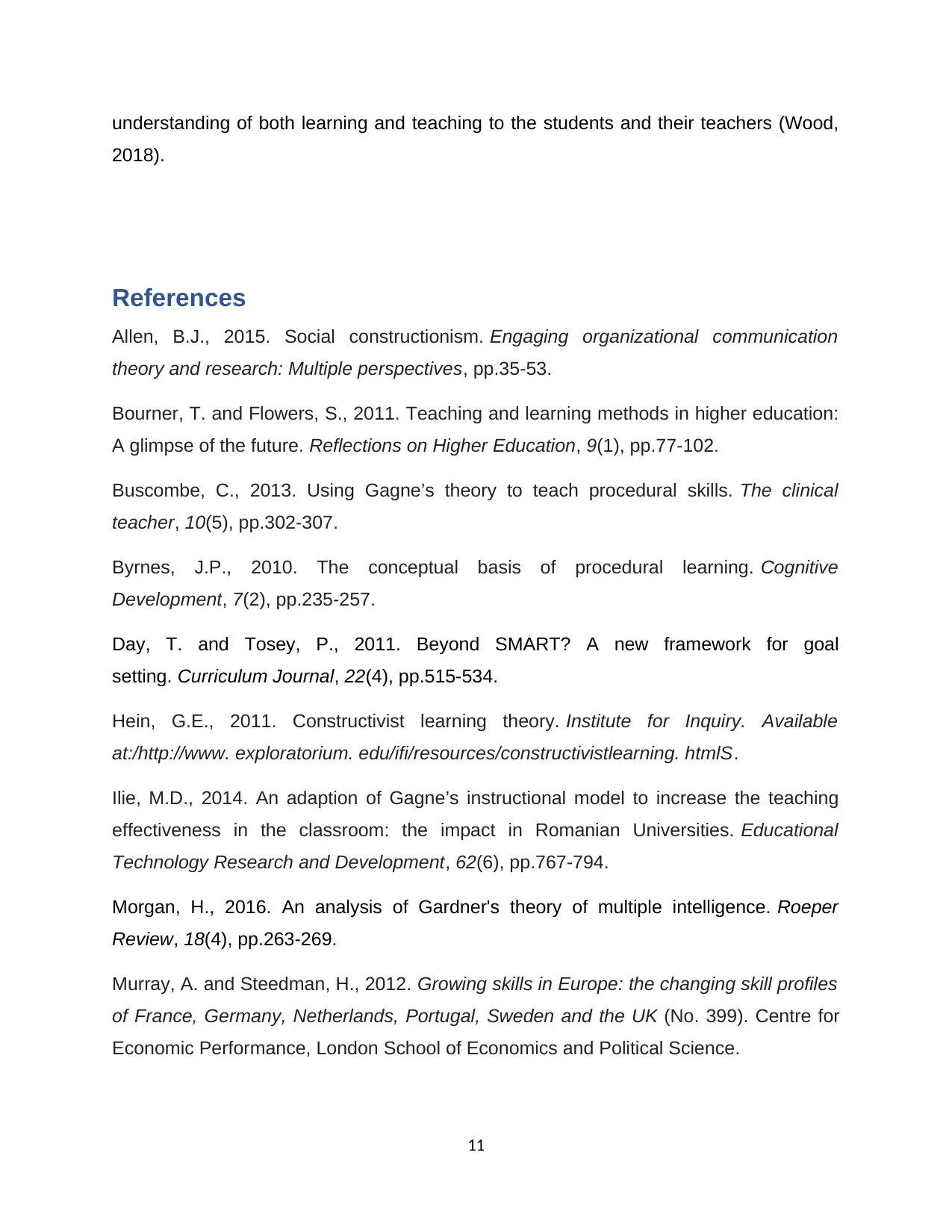
understanding of both learning and teaching to the students and their teachers (Wood,
2018).
References
Allen, B.J., 2015. Social constructionism. Engaging organizational communication
theory and research: Multiple perspectives, pp.35-53.
Bourner, T. and Flowers, S., 2011. Teaching and learning methods in higher education:
A glimpse of the future. Reflections on Higher Education, 9(1), pp.77-102.
Buscombe, C., 2013. Using Gagne’s theory to teach procedural skills. The clinical
teacher, 10(5), pp.302-307.
Byrnes, J.P., 2010. The conceptual basis of procedural learning. Cognitive
Development, 7(2), pp.235-257.
Day, T. and Tosey, P., 2011. Beyond SMART? A new framework for goal
setting. Curriculum Journal, 22(4), pp.515-534.
Hein, G.E., 2011. Constructivist learning theory. Institute for Inquiry. Available
at:/http://www. exploratorium. edu/ifi/resources/constructivistlearning. htmlS.
Ilie, M.D., 2014. An adaption of Gagne’s instructional model to increase the teaching
effectiveness in the classroom: the impact in Romanian Universities. Educational
Technology Research and Development, 62(6), pp.767-794.
Morgan, H., 2016. An analysis of Gardner's theory of multiple intelligence. Roeper
Review, 18(4), pp.263-269.
Murray, A. and Steedman, H., 2012. Growing skills in Europe: the changing skill profiles
of France, Germany, Netherlands, Portugal, Sweden and the UK (No. 399). Centre for
Economic Performance, London School of Economics and Political Science.
11
2018).
References
Allen, B.J., 2015. Social constructionism. Engaging organizational communication
theory and research: Multiple perspectives, pp.35-53.
Bourner, T. and Flowers, S., 2011. Teaching and learning methods in higher education:
A glimpse of the future. Reflections on Higher Education, 9(1), pp.77-102.
Buscombe, C., 2013. Using Gagne’s theory to teach procedural skills. The clinical
teacher, 10(5), pp.302-307.
Byrnes, J.P., 2010. The conceptual basis of procedural learning. Cognitive
Development, 7(2), pp.235-257.
Day, T. and Tosey, P., 2011. Beyond SMART? A new framework for goal
setting. Curriculum Journal, 22(4), pp.515-534.
Hein, G.E., 2011. Constructivist learning theory. Institute for Inquiry. Available
at:/http://www. exploratorium. edu/ifi/resources/constructivistlearning. htmlS.
Ilie, M.D., 2014. An adaption of Gagne’s instructional model to increase the teaching
effectiveness in the classroom: the impact in Romanian Universities. Educational
Technology Research and Development, 62(6), pp.767-794.
Morgan, H., 2016. An analysis of Gardner's theory of multiple intelligence. Roeper
Review, 18(4), pp.263-269.
Murray, A. and Steedman, H., 2012. Growing skills in Europe: the changing skill profiles
of France, Germany, Netherlands, Portugal, Sweden and the UK (No. 399). Centre for
Economic Performance, London School of Economics and Political Science.
11
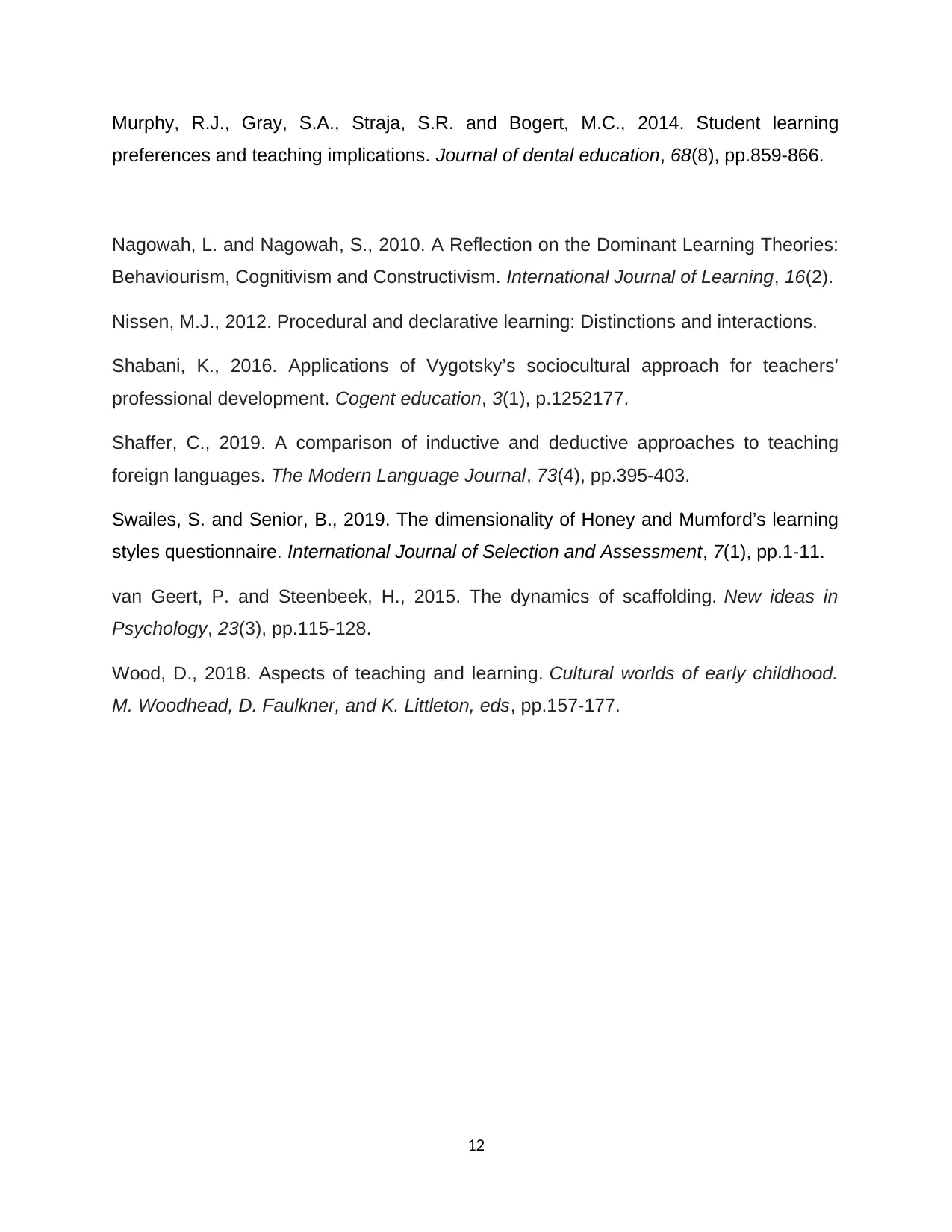
Murphy, R.J., Gray, S.A., Straja, S.R. and Bogert, M.C., 2014. Student learning
preferences and teaching implications. Journal of dental education, 68(8), pp.859-866.
Nagowah, L. and Nagowah, S., 2010. A Reflection on the Dominant Learning Theories:
Behaviourism, Cognitivism and Constructivism. International Journal of Learning, 16(2).
Nissen, M.J., 2012. Procedural and declarative learning: Distinctions and interactions.
Shabani, K., 2016. Applications of Vygotsky’s sociocultural approach for teachers’
professional development. Cogent education, 3(1), p.1252177.
Shaffer, C., 2019. A comparison of inductive and deductive approaches to teaching
foreign languages. The Modern Language Journal, 73(4), pp.395-403.
Swailes, S. and Senior, B., 2019. The dimensionality of Honey and Mumford’s learning
styles questionnaire. International Journal of Selection and Assessment, 7(1), pp.1-11.
van Geert, P. and Steenbeek, H., 2015. The dynamics of scaffolding. New ideas in
Psychology, 23(3), pp.115-128.
Wood, D., 2018. Aspects of teaching and learning. Cultural worlds of early childhood.
M. Woodhead, D. Faulkner, and K. Littleton, eds, pp.157-177.
12
preferences and teaching implications. Journal of dental education, 68(8), pp.859-866.
Nagowah, L. and Nagowah, S., 2010. A Reflection on the Dominant Learning Theories:
Behaviourism, Cognitivism and Constructivism. International Journal of Learning, 16(2).
Nissen, M.J., 2012. Procedural and declarative learning: Distinctions and interactions.
Shabani, K., 2016. Applications of Vygotsky’s sociocultural approach for teachers’
professional development. Cogent education, 3(1), p.1252177.
Shaffer, C., 2019. A comparison of inductive and deductive approaches to teaching
foreign languages. The Modern Language Journal, 73(4), pp.395-403.
Swailes, S. and Senior, B., 2019. The dimensionality of Honey and Mumford’s learning
styles questionnaire. International Journal of Selection and Assessment, 7(1), pp.1-11.
van Geert, P. and Steenbeek, H., 2015. The dynamics of scaffolding. New ideas in
Psychology, 23(3), pp.115-128.
Wood, D., 2018. Aspects of teaching and learning. Cultural worlds of early childhood.
M. Woodhead, D. Faulkner, and K. Littleton, eds, pp.157-177.
12
⊘ This is a preview!⊘
Do you want full access?
Subscribe today to unlock all pages.

Trusted by 1+ million students worldwide
1 out of 35
Related Documents
Your All-in-One AI-Powered Toolkit for Academic Success.
+13062052269
info@desklib.com
Available 24*7 on WhatsApp / Email
![[object Object]](/_next/static/media/star-bottom.7253800d.svg)
Unlock your academic potential
Copyright © 2020–2025 A2Z Services. All Rights Reserved. Developed and managed by ZUCOL.





